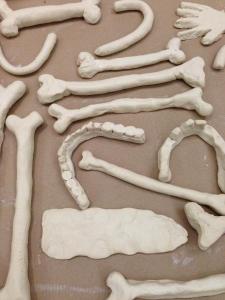Student organizations raise genocide awareness with art activism project.
On Monday, March 5, Mason’s Cultural Integration Association, Table for Two GMU and Mason’s Working Group on Displaced Populations hosted an art activism event called “One Million Bones” to raise awareness about genocide.
Students participated by sculpting clay bones in Dewberry Hall to send to the One Million Bones project. The Cultural Integration Association succeeded in obtaining 432 bones, just 68 short of its goal of 500.
“It definitely was a great contribution,” said Lela Ross, vice president of the Cultural Integration Association.
One Million Bones is an artistic activist social movement founded by Naomi Natale, an activist and artist, to bring awareness to ongoing genocides around the world. The project will display 1,000,000 homemade clay bones at the National Mall in D.C. in June 2013, visually representing genocide atrocities as a mass grave. The project also raises funds for the humanitarian organization CARE, which aids women and children in impoverished nations around the globe. Every bone made in a One Million Bones event or as a donation will raise one dollar for CARE.
“It was nice to see everyone connecting and building bones together for a good cause,” Ross said.
 |
| Students sculpted bones to raise genocide awareness (photo by Audrey Mattaino). |
Ross and Cultural Integration Association’s president Zeineb Bawezir, the founders of the Cultural Integration Association, decided to host the One Million Bones event as their first campus event since forming in spring 2012.
“We really wanted to do something regarding genocide,” Ross said.
The association is focusing on encouraging students to “start intermingling more” through volunteer work and cultural events.
“We both decided there was a lot of diversity on campus, but people tend to stay within their own groups,” Ross said. “We kind of wanted to help foster change.”
Mason’s Working Group on Displaced Populations co-hosted the event. The working group was formed in fall 2010 by faculty, students and alumni working towards obtaining a Center for Displaced Populations for Mason, which would aid in research, instruction and awareness about displaced communities. Students in the NCLC 416, a refugee and internal displacement course, which works with Mason’s Working Group on Displaced Populations, also participated in the event for experiential learning credit.
Mason’s chapter of the non-profit organization Table for Two also co-hosted the event. Table for Two GMU aims to solve both obesity and hunger by working with local restaurants and cafeterias to provide healthy meals to be bought in the U.S. For each meal bought, 25 cents go towards providing developing African countries with school lunches.
The Cultural Integration Association is planning on continuing a project started for the Clinton Global Initiative University. The Clinton Global Initiative University, modeled after the Clinton Global Initiative, is a yearly conference of college students who collaborate on a service project to alleviate a local or global issue such as environmental, education or global health concerns.
“We created a project where students in Fairfax are asked to donate school supplies and basic first aid items, and these items would be transported to schools in Yemen,” Ross said. “To help students connect and integrate culturally, we decided to set up a pen pal system as well so students can write in their own native languages and translators will translate them into English or Arabic.”
Ross said the association was considering a few small volunteer events as well.
“We believe that diversity without intercultural cooperation, understanding and friendship can lead to negative exclusionary attitudes,” the Cultural Integration Association’s CollegiateLink site says. “Diversity is not a demographic statistic; it is a process that must be fostered and sustained.”
